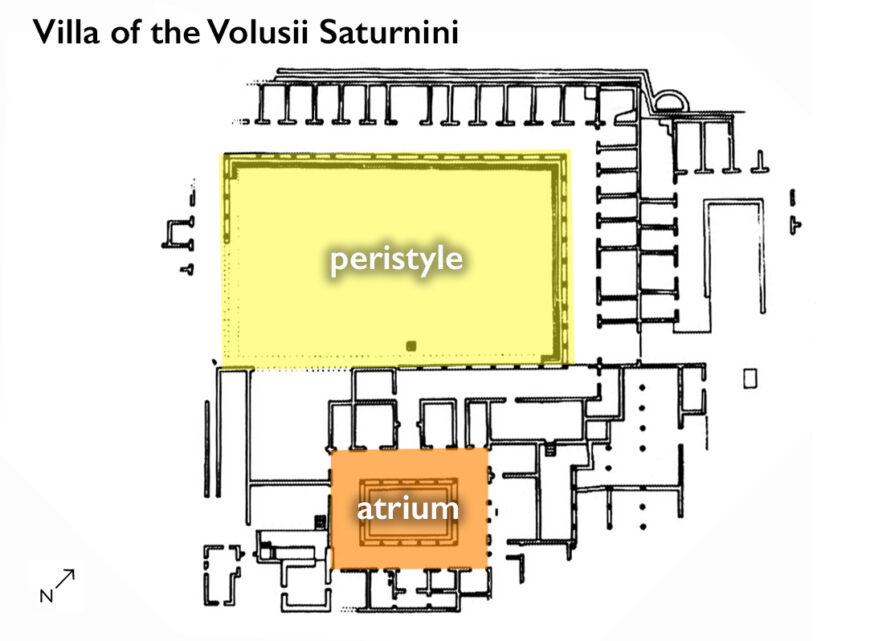To escape the heat and pressures of the city, the wealthiest Roman families retreated to their country homes.
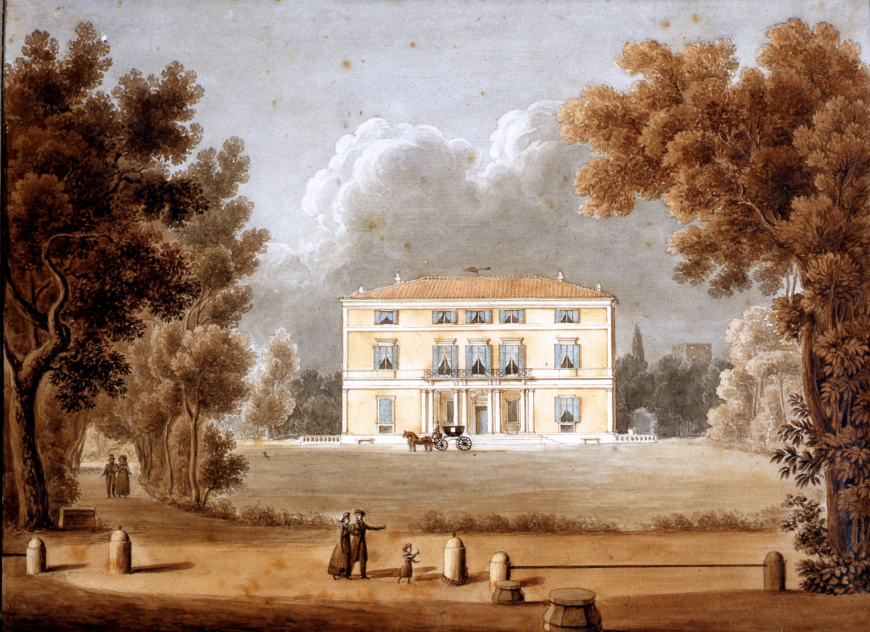
Giovanni Riveruzzi, View of the Casino and the park of Villa Paolina from the side of Porta Pia, 1828, watercolor on paper (Museo Napoleonico). This villa belonged to Paolina Bonaparte, sister of Napoleon, though it dates back to the 17th century.
Familiar but enigmatic
The villa, on its face, seems to be the simplest of Roman domestic buildings to understand—after all, we continue to use the Latin term “villa” to conjure up a luxurious retreat in the country or at the seashore.
We find evidence of the ancient Roman villa in both archaeological remains and in ancient texts. Taken together this would seem to suggest a fairly uniform and monolithic body of architecture, while the reality is, in fact, something quite different. In some ways the Roman villa is a conundrum. This is especially true in the earlier phases of the type’s development, where questions of origins and influence remain hotly debated. As a building type, the villa manages to simultaneously seem instantly understandable and completely enigmatic.
History
The earliest examples of buildings grouped into this category, sometimes referred to by the term villa rustica (country villa), are mostly humble farmhouses in Italy. These rural structures tend to be associated with agriculture or viticulture (grapes) on a small scale. The villa form—and the term itself—then comes to be appropriated and applied to a whole range of structures that persist across both the Republican and Imperial periods, continuing into Late Antiquity. One thing that all villas tend to have in common is their extra-urban setting—the villa is not an urban structure, but rather a rural one. Thus we most often find them in rural, suburban or coastal settings. In ideological terms, the country (rus) provided relief from the hectic pressures of the city (urbs), and thus the villa became associated (and remains associated) with rural getaways.
According to Pliny the Elder, the villa urbana was located within easy distance of the city, while the villa rustica was a permanent country estate staffed with enslaved individuals and a supervisor (vilicus). The villa rustica is connected with agricultural production and the villa complex can contain facilities and equipment for processing agricultural produce, notably processing grapes to make wine and processing olives to produce olive oil. Even opulent villas often had a pars rustica, the working or productive part of the building. Latin authors like Cato the Elder and Varro even made and observed strict recommendations, based in agrarian ideology, as to how these rustic villas should be built, appointed, and managed.
Building typology
It is difficult to identify a single, uniform typology for Roman villas, just as it is difficult to do so for the Roman house (domus). In general terms the ideal villa is internally divided into two zones: the urbane zone for enjoying life (pars urbana) and the productive area (pars rustica). As with domus architecture, villas often focus internally around courtyards and atrium spaces. Elite villas tend to be sprawling affairs, with many rooms for entertainment and dining, in addition to specialized facilities including heated baths (balnea).
Republican villas
Villas built in Italy during the period stretching from the fifth to the second centuries B.C.E. can be divided into several groupings, based on their building typology. One typology with the smallest number of known examples is an opulent villa that draws its influence from the tradition of palatial aristocratic compounds of the Archaic period in central Italy, such as the complex at Poggio Civitate (Murlo) and the “palace” at Acquarossa (near Viterbo). These aristocratic compounds might have inspired Roman Republican aristocrats to build similar aristocratic mansions for their extended families as a demonstration of their social and economic clout. Other Republican-period “villas” tend to be small and connected with agricultural production on a small scale. Traditionally they are associated with an open-air, yet enclosed, courtyard that serves as a focal point.
The mid-first century B.C.E. villa of the Volusii Saturnini at Lucus Feroniae provides a good example of an opulent villa built by Late Republican new money. It also demonstrates the pattern that many elite villas would follow during the Imperial period in becoming ever more opulent. In the plan, we see a large peristyle and smaller atrium and dozens of rooms off each.
Ancient writers the likes of Cato the Elder, Varro, and Columella theorized that villa architecture evolved over time, with the so-called “Columellan” villa being the most elaborate and sophisticated. While scholars do not accept this evolutionary schema any longer, it is interesting that these ancient authors were focused on villas and their culture and that they appreciated change over time. While the archaeological remains do not bear out or prove this theory of architectural development, the awareness of the villa and its role in Roman ideology is an important concept on its own.
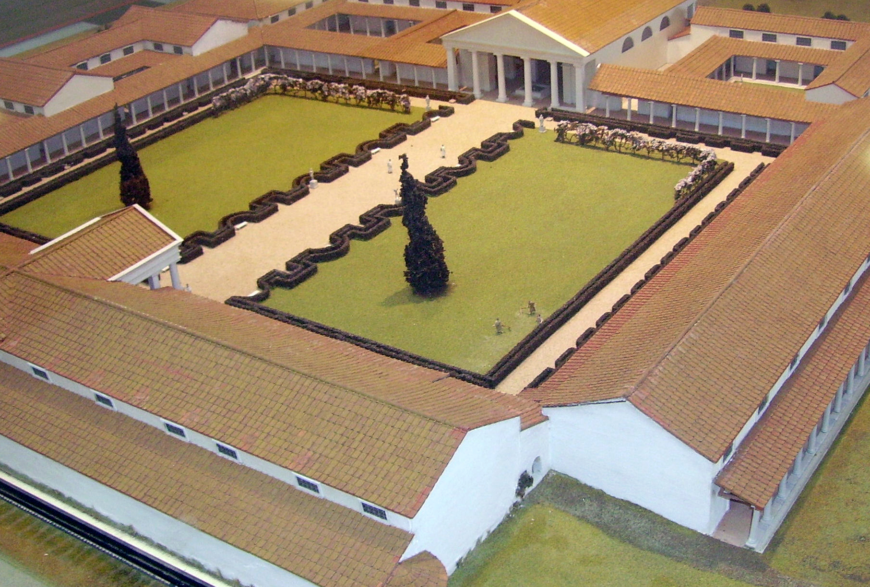
Model of the Fishbourne Roman Palace (Fishbourne Roman Palace Museum; photo: Immanuel Giel)
Imperial villas
From the Imperial period, we are fortunate to have evidence for a wide range of villa architecture distributed across the Roman empire. In the provinces of the Roman Empire, the adoption of classic villa architecture seems to serve as a mark of adopting a Roman lifestyle—with elites keen to demonstrate their urbanity by living in villas. An example of such an adoption is the so-called Fishbourne Roman palace at Chichester in the south of England which was likely the seat of the Roman client-king Cogidubnus.
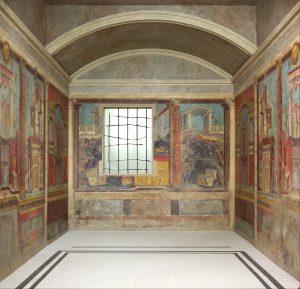
Frescos in the Cubiculum (bedroom) from the Villa of Publius Fannius Synistor at Boscoreale, c. 50–40 B.C.E. (The Metropolitan Museum of Art)
A number of villas destroyed by the 79 C.E. eruption of Mount Vesuvius demonstrate key features of the opulent villa. At Boscoreale the Late Republican villa of Publius Fannius Synistor (c. 50–40 B.C.E.) is well known for its elaborate Second Style wall paintings.
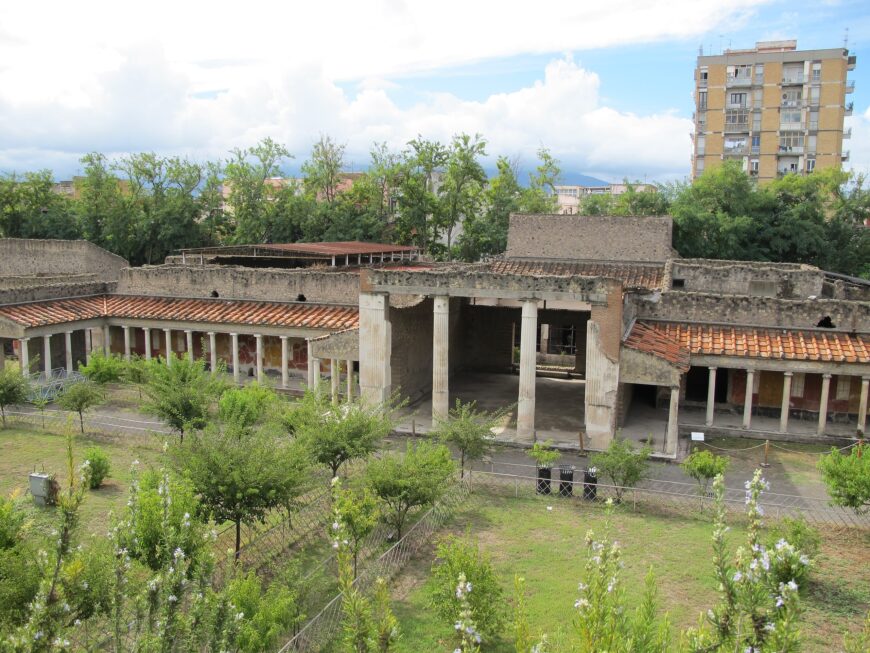
Villa Oplontis, first century C.E. with later remodeling (photo: ho visto nina volare, CC BY-SA 2.0)
At Oplontis (modern Torre Annunziata, Italy), the so-called Villa A (sometimes referred to as Villa Poppaea) demonstrates the seaside villa (villa maritima). This is a grand pleasure villa, with many well-appointed rooms for leisure and reception.
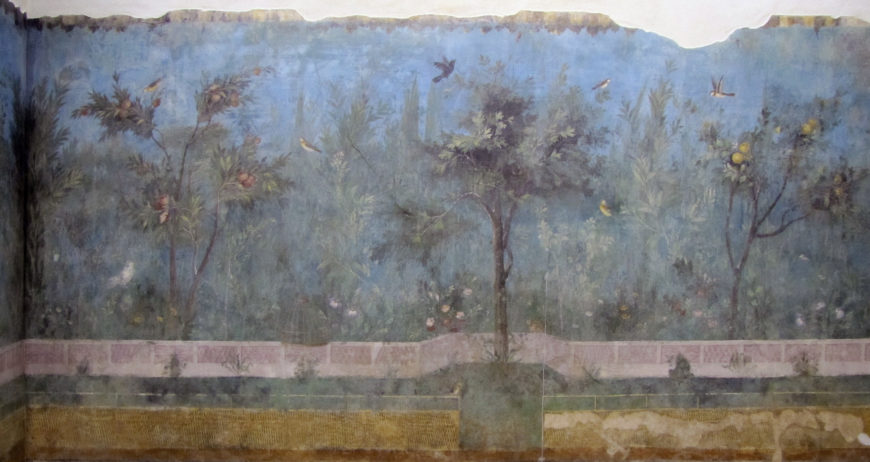
Painted Garden, removed from the triclinium (dining room) in the Villa of Livia Drusilla, Prima Porta, fresco, 30–20 B.C.E. (Museo Nazionale Romano, Palazzo Massimo, Rome; photo: Steven Zucker, CC BY-NC-SA 2.0)
In the periphery of Rome itself we find a number of villas connected with the Imperial house. These are mostly villas of the villa urbana category—including examples such as the Villa of Livia at Prima Porta that belonged to Livia, the wife of the emperor Augustus. The Prima Porta villa—a private Imperial retreat—is famous for its garden-themed dining room and the portrait statue of Augustus of Prima Porta.
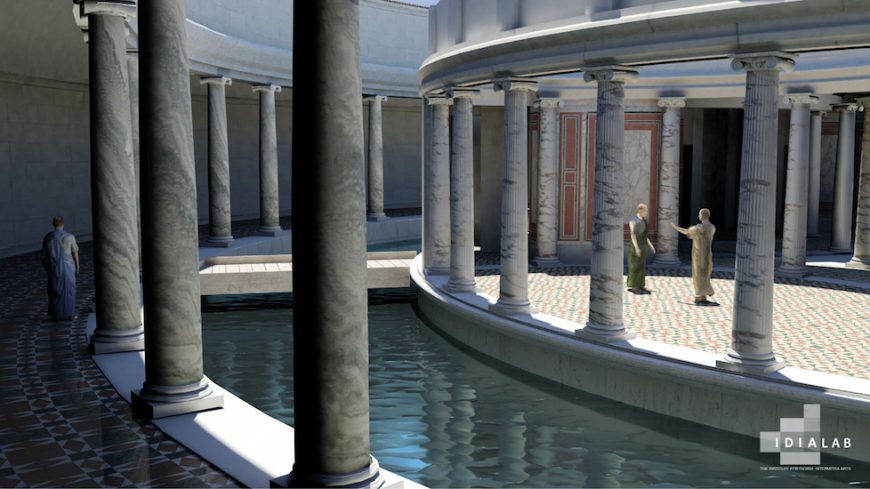
Reconstruction, Maritime Theater, Hadrian’s Villa, Tivoli, 2nd century C.E. (photo: The Digital Hadrian’s Villa Project, Institute for Digital Intermedia Arts, Ball State University, Dr. Bernard Frischer and John Fillwalk)
Other emperors would build their own suburban villas as well. Worthy of note in this category is the Villa of Hadrian at Tivoli located to the east of Rome. A series of later elite villas (mostly south of Rome) such as the Villa of Maxentius on the Via Appia and the Villa of the Quintilii, show us that the villa continued to be not only a statement of status into the later Roman period, but also maintained its role as a retreat from the crowded confusion of the city.
Late Roman
In Late Antiquity the Roman villa continued to develop. The so-called Villa Romana del Casale just outside of Piazza Armerina, Sicily, was built in the early fourth century C.E. and boasts one of the most complex programs of Roman mosaics preserved from the ancient world.
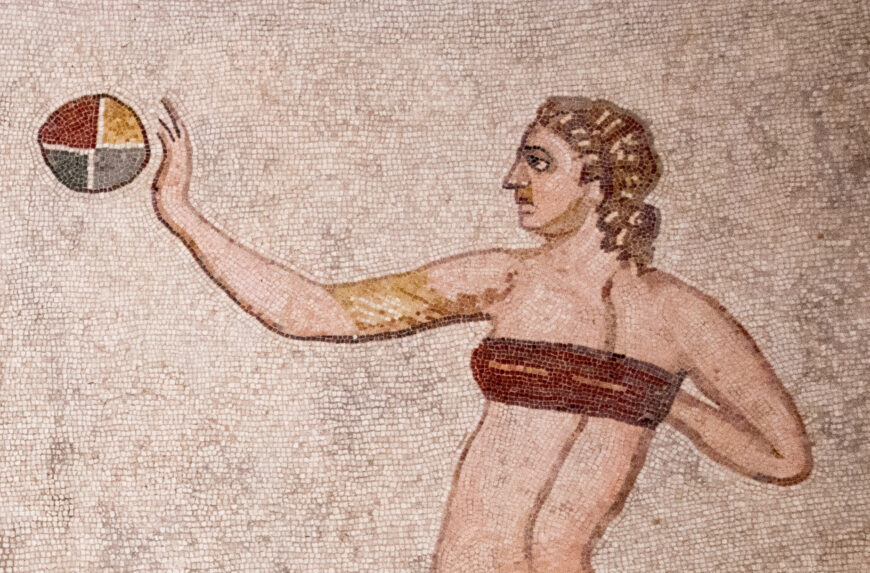
Mosaic from the “Chamber of the Ten Maidens,” Villa Romana del Casale, Sicily, 3rd–4th century C.E. (photo: Paul Asman and Jill Lenoble, CC BY 2.0)
The Villa Casale was likely the center of a large agricultural estate (latifundium) and its opulent decorations strongly suggest the elite status of its owners. The villa has three sectors that focus on a central peristyle. It seems that the complex was built as a simultaneous project. Its mosaic decorations are rich and complex, with themes that range from natural and geometric scenes, to genre scenes, to hunting scenes, as well as scenes extracted from Graeco-Roman mythology. Villas like the Villa Casale dominated the rural landscape and its economy, engaging in various productive activities from farming to mining.
Roman rural villas remained prominent features in post-Roman landscapes, in some cases becoming centers of monastic life and in others becoming the centers of emergent villages during the Medieval period.
Additional resources
UNESCO: Villa Romana del Casale.
Jeffrey A. Becker and Nicola Terrenato. eds. Roman Republican Villas: Architecture, Context, and Ideology (Ann Arbor: University of Michigan Press, 2012).
Bettina Bergmann, “Art and nature in the villa at Oplontis,” in T. A. McGinn ed., Pompeian brothels, Pompeii’s ancient history, mirrors and mysteries, art and nature at Oplontis, & the Herculaneum “Basilica” (Journal of Roman Archaeology Supplement 47) (Portsmouth RI: Journal of Roman Archaeology, 2002), pp. 87-120.
Andrea Carandini, Andreina Ricci, and Mariette De Vos, Filosofiana, The villa of Piazza Armerina: the image of a Roman aristocrat at the time of Constantine (Palermo : S.F. Flaccovio, 1982).
Jesper Carlsen, Vilici and Roman Estate Managers Until AD 284, Part 284 (Rome: “L’Erma” di Bretschneider, 1995).
John R. Clarke, The Houses of Roman Italy, 100 B.C.-A.D. 250: ritual, space, and decoration (Berkeley: University of California Press, 1991)
M. Aylwin Cotton, The late Republican villa at Posto Francolise (London: The British School at Rome, 1979).
M. Aylwin Cotton and Guy P. R. Métraux, The San Rocco villa at Francolise (London: The British School at Rome, 1985).
Pierre de la Ruffinière Du Prey, The Villas of Pliny from Antiquity to Posterity (Chicago: University of Chicago Press, 1994).
Stephen L. Dyson, The Roman Countryside (Duckworth Debates in Archaeology) (London: Duckworth, 2003).
Riccardo Francovich and Richard Hodges, Villa to Village: The Transformation of the Roman Countryside (Duckworth Debates in Archaeology) (London: Duckworth, 2003).
Wilhelmina Jashemski and E. B. MacDougall, Ancient Roman Gardens (Washington, D.C.: Dumbarton Oaks Trustees for Harvard University, 1981).
Vincent Jolivet ed., Suburbium II: il suburbio di Roma dalla fine dell’età monarchica alla nascita del sistema delle ville (V-II secolo a.C.) (Rome: École française de Rome, 2009).
Xavier Lafon, Villa Maritima: recherches sur les villas littorales de l’Italie romaine: IIIe siècle av. J.C.-IIIe siècle ap. J.-C (Rome: École française de Rome, 2001).
Ray Laurence and Andrew Wallace-Hadrill, eds., Domestic Space in the Roman World: Pompeii and beyond (Portsmouth RI: Journal of Roman Archaeology, 1997).
Ray Laurence, Roman Pompeii: Space and Society (London: Routledge, 1994).
Eleanor W. Leach, The rhetoric of space: literary and artistic representations of landscape in Republican and Augustan Rome (Princeton: Princeton University Press, 1988).
Eleanor W. Leach, The social life of painting in Ancient Rome and on the bay of the Naples (Cambridge: Cambridge University Press, 2004).
William L. MacDonald and John Pinto, Hadrian’s Villa and its Legacy (New Haven: Yale University Press, 1995).
Annalisa Marzano, Roman Villas in Central Italy: a Social and Economic History (Leiden: E. J. Brill, 2007).
Alexander M. McKay, Houses, Villas and Palaces in the Roman World (Ithaca, N.Y.: Cornell University Press, 1975).
Lisa C. Nevett, Domestic space in Classical Antiquity (New York: Cambridge University Press, 2010).
John Percival, The Roman Villa: an historical introduction 2nd ed. (Berkeley: University of California Press, 1981).
Jane Clark Reeder, The Villa of Livia Ad Gallinas Albas. A Study in the Augustan Villa and Garden (Providence RI: Center for Old World Archaeology and Art, 2001).
Lucia Romizzi, Ville d’otium dell’Italia antica: (II sec. a.C. – I sec. d.C.) (Naples: Edizioni scientifiche italiane, 2001).
J. T. Smith, Roman Villas: a Study in Social Structure (London: Routledge, 1997).
Walter M. Widrig, Marshall J. Becker, and Joann Freed, “Loc. Tor Bella Monaca: excavations on the ancient via Gabina; second preliminary report,” Notizie degli scavi di antichità 37 (1983) pp. 141-182.
Walter M. Widrig, The Via Gabina villas: sites 10, 11, and 13 (Houston: Rice University, 2009). Online companion
Roger John Anthony Wilson, Piazza Armerina (Austin TX: University of Texas Press, 1983).

